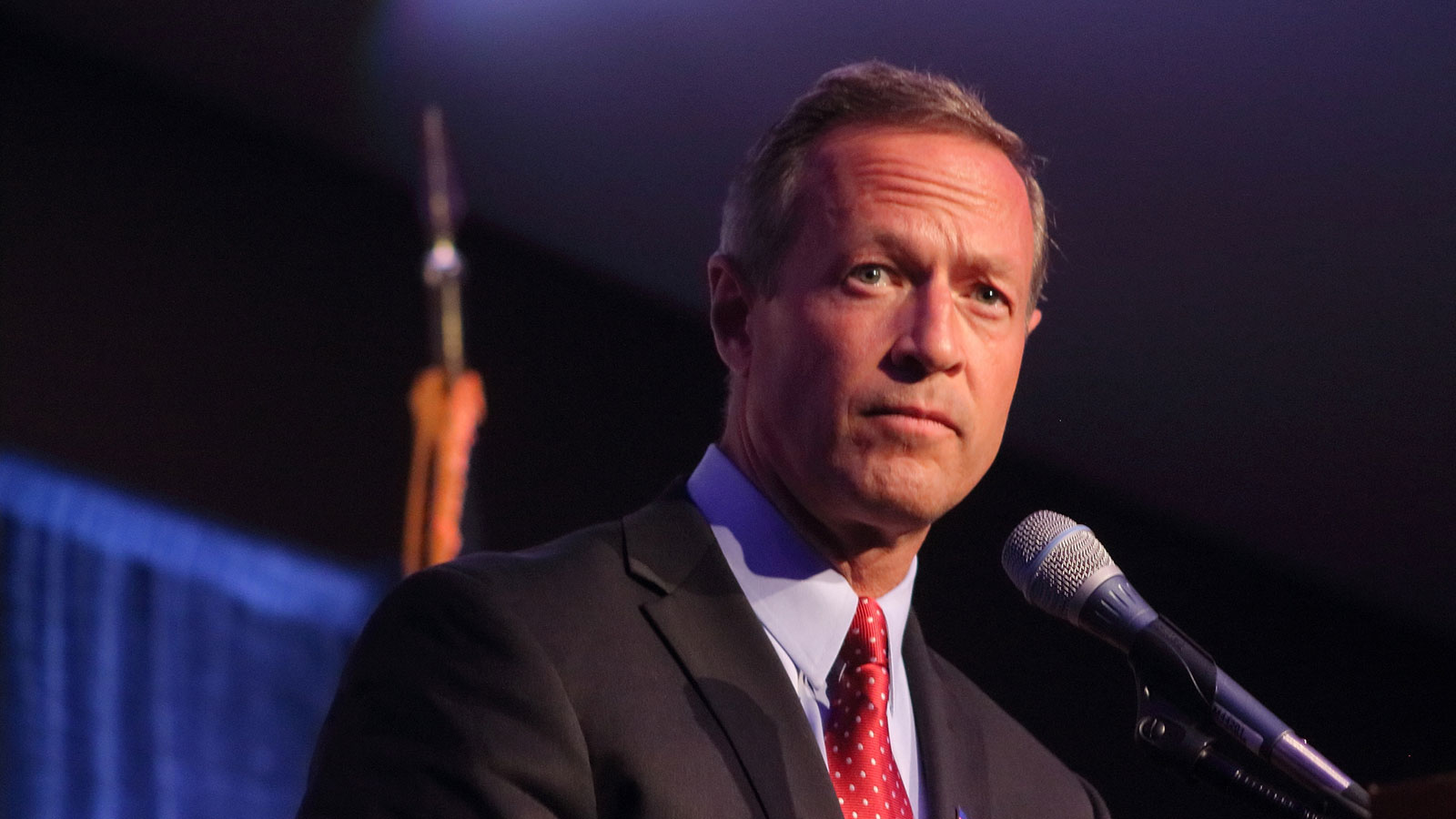Say what you will about Martin O’Malley, the former Maryland governor and current Democratic presidential candidate, but the man is a wonk. He may lack for narrative, but he will give you plenty of commonsense solutions. And he has a demonstrated commitment to combatting climate change.
So perhaps it should come as no surprise that despite his lagging far behind Hillary Clinton and even lefty Sen. Bernie Sanders (I-Vt.) in the polls, he is the first candidate to produce anything resembling a detailed climate policy. It’s only a work in progress, and it isn’t even available yet on the campaign website. But O’Malley’s team shared with Grist a white paper outlining some significant climate change policy proposals. Collectively, they would go further than President Obama has — or than Hillary Clinton has called for thus far.
O’Malley’s plans go on for two full pages. The first lists things he would do through executive authority. Here are some of the highlights, in the white paper’s own words:
- Direct the Environmental Protection Agency to take aggressive action to limit greenhouse gases, expanding rules to other large sources of emissions beyond power plants.
- Direct the Environmental Protection Agency to adopt a zero-tolerance policy for methane leaks from current oil and gas production.
- Reject projects like Keystone XL that exacerbate climate change and extend our reliance on fossil fuels.
- Deny new permits for drilling in Alaska, Antarctica, and off our coasts.
- Increase royalties and emissions fees for fossil fuel companies currently drilling on federal lands.
And here are some of the most important policies that O’Malley says he would fight for in Congress:
- Set a national, cross-sector Renewable Electricity Standard so our nation is powered by 100% clean energy by 2050.
- Fight for federal legislation for a cap on carbon emissions from all sources, with proceeds from permits returned to lower-and middle-class families and invested in job transition assistance and the Clean Energy Corps.
- Set a national goal of doubling our energy productivity within 15 years.
- End all subsidies for fossil fuels, while extending production and investment tax credits for renewable energy for the long term.
Some of these goals overlap with Obama’s and Clinton’s. Obama’s EPA has already proposed carbon emissions regulations for power plants, and it can’t propose opening new avenues until those rules are in place, which won’t happen until after Obama leaves office. But it’s worth noting that O’Malley explicitly promises to expand carbon regulation to other major sources. O’Malley is presumably referring to other stationary sources of greenhouse gases such as industrial and agricultural activity, which respectively account for 21 and 9 percent of U.S. emissions. EPA has already raised fuel efficiency standards, and therefore reduced emissions, for mobile sources such as cars and trucks. Transportation is responsible for 27 percent of U.S. emissions and electricity generation represents 31 percent. In other words, there is potentially as much to be gained from going after industry and agriculture as power plants.
When Clinton addressed the League of Conservation Voters last year, she said, regarding the Clean Power Rule, “The unprecedented action that President Obama has taken must be protected at all cost.” That’s hugely important, because congressional Republicans are certain to keep attacking it. But promising to also tackle other major sources is even better.
On methane leaks, a growing source of greenhouse gas emissions thanks to the fracking boom, O’Malley promises to go considerably farther than Obama. In January, the Obama administration laid out a plan to reduce methane leakage, but climate hawks were underwhelmed. As I explained at the time, the Obama administration intends only to regulate new and modified wells, even though existing wells will continue to operate and leak. According to an Environmental Defense Fund study, wells in operation since 2011 will account for up to 90 percent of methane emissions from oil and gas in 2018. O’Malley’s promise to regulate methane leaks from current wells would address that.
Another key difference between O’Malley and Obama is that O’Malley doesn’t subscribe to Obama’s “all of the above” energy policy. While Obama tries to boost domestic production of oil and gas along with renewables, O’Malley is focused solely on the latter. So O’Malley promises to reject the Keystone XL pipeline, which Obama hasn’t taken a stance on yet, and to block other proposals to invest in fossil fuel infrastructure. O’Malley also would reject proposals to drill off American coasts, whereas Obama plans to open areas of the Atlantic and Arctic Oceans to oil and gas leasing.
On all of these issues, it’s impossible to know where exactly Hillary Clinton stands in relation to Obama and O’Malley. As Obama’s secretary of state, Clinton could not publicly contradict Obama’s policies. Like Obama, she hasn’t taken a stance on Keystone. As a senator, Clinton supported offshore drilling, and as secretary of state she promoted fracking abroad.
One point of agreement among the Democrats that is long overdue: O’Malley and Clinton both say they would charge more for fossil fuel leases on federal land, something the Obama administration is finally just beginning to work on.
O’Malley’s plans to call for various actions from Congress are less important, since he is unlikely to get them passed. Republican control of the House of Representatives is unlikely to change before 2023 because of partisan gerrymandering.
But a lot can change in politics in just a few years. In 2008, Republican presidential nominee John McCain proposed cap-and-trade legislation. A year later he wouldn’t support the exact same sort of bill. Maybe Republicans will come around to saving the planet.
If they do, O’Malley’s proposals would look a lot like Obama’s: setting a carbon cap and selling permits and investing in renewables and eliminating fossil fuel subsidies. O’Malley would set even more ambitious goals than Obama. The president came into office aiming for 10 percent renewable sources of electricity by 2012, and 25 percent by 2025. Right now, we’re at 13 percent. O’Malley wants 100 percent renewable electricity by 2050, and doubling our energy productivity by 2030. (Energy productivity measures the dollars of economic output produced from a given amount of energy consumption. It overlaps significantly with energy efficiency, but is a different way of measuring progress.)
In the months ahead, according to his campaign, O’Malley will emphasize the importance of climate change and release further, more detailed proposals.
Last Thursday, when Pope Francis issued his encyclical calling for action to address climate change, O’Malley, a Catholic, published an op-ed in USA Today proposing to eliminate fossil fuel energy by 2050. A few paragraphs in particular stand out:
Clean energy represents the biggest business and job creation opportunity we’ve seen in a hundred years. And reliance on local, renewable energy sources means a more secure nation and a more stable world.
Given the grave threat that climate change poses to human life on our planet, we have not only a business imperative but a moral obligation to future generations to act immediately and aggressively.
This is why protecting the United States from the devastating impact of climate change — while capitalizing on the job creation opportunity of clean energy — is at the center of my campaign for president.
Like Sanders, who is a prominent climate hawk, O’Malley is promising to treat climate change — an issue that is often marginalized even by pro-environment candidates — as the hugely important challenge that it is. And O’Malley, like Sanders, is unafraid to set himself apart from Obama and the centrist, corporatist wing of his party that embraces fossil fuel development. “We cannot meet the climate challenge with an all-of-the-above energy strategy, or by drilling off our coasts, or by building pipelines that bring oil from tar sands in Canada,” O’Malley writes in USA Today. “Instead, we must be intentional and committed to one over-arching goal as a people: a full, complete transition to renewable energy — and an end to our reliance on fossil fuels.” Environmental leaders such as NextGen Climate founder Tom Steyer and Sierra Club executive director Michael Brune praised O’Malley’s op-ed for its boldness.
When Sanders issues climate change policy proposals, they will surely be strong — although it remains to be seen whether he will match O’Malley in committing to clamping down on fossil fuel production. But the really big question looming over the Democratic primary is whether Clinton will offer ambitious new proposals like O’Malley’s — or just more of the same half-measures as Obama.



